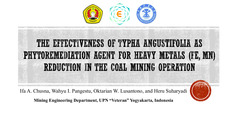The effectiveness of typha angustifolia as phytoremediation agent for heavy metals (Fe, Mn) reduction in the coal mining operation
编号:315
稿件编号:343 访问权限:公开
更新:2022-05-26 13:15:16
浏览:1348次
口头报告

报告开始:2022年05月26日 15:00 (Asia/Shanghai)
报告时间:20min
所在会议:[S2] Environmental Science and Engineering » [S2-1] Theme 1 & 2
摘要
Mine water management is a systematic methodology to manage water as a direct or indirect generated from mining activities within the operation area. The water management methods are divided into two major categories; active and passive treatment. This field study aims to investigate the effectiveness of passive treatment in settling ponds with wetland systems implemented using Typha angustifolia as a phytoremediation agent in a coal mining operation. This study overlooked the heavy metals component, such as Iron (Fe) and Manganese (Mn) as a product of mine drainage and Typha angustifolia as a heavy metal accumulator. The locations for sampling water, such as disposal material, wetland area, and river. From the laboratory testing with the Atomic Absorption Spectrophotometer (AAS) testing. The concentration of Fe and Mn in the inlet of the wetland are 0.341 and 0.019 mg/L respectively. Water is directed into the wetland through open channels, processed for 30 days, and Fe and Mn accumulation in plants are 137.86 and 87.15 mg/Kg. The passive treatment results in the concentration of heavy metals Fe and Mn in the outlet are 0.086 and 0.011 mg/L respectively. This study showed that Typha angustifolia could reduce Fe and Mn concentrations by 74.79% and 40.23% on average.
关键字
water management,phytoremediation,heavy metals,wetland system
发表评论